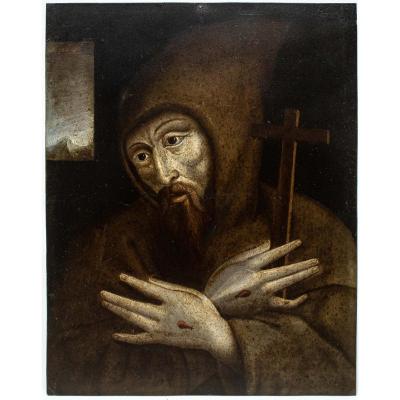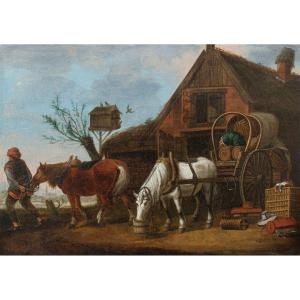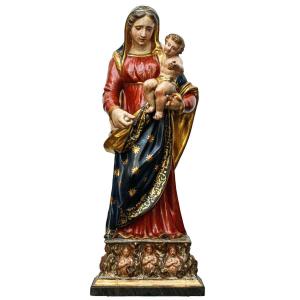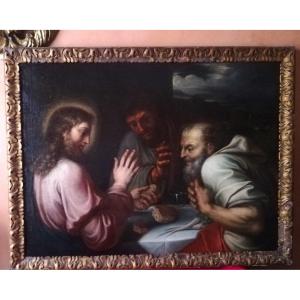Caprice with biblical scene
Oil on canvas, cm 50 x 74
The work in question depicts a biblical episode within a background of classical architectural ruins. More precisely, the second miracle of Peter is narrated. In Jaffa lived a seamstress named Tabita known for her goodness and charitable works. At one point, Tabitas fell ill and died: the other disciples, hearing that Peter was in the nearby city of Lidda, sent for him. When he arrived at the house of Tabita, Peter met other widows in tears, who showed him the clothes that the woman used to make them. The apostle prayed alone in the room where Tabita had been left, and said, "Tabita, get up!" when he had said these words, the woman rose again.
The sequence of arches flanked by what remains of an Ionic temple, as well as the rocks and the bases of columns, among which the figures recall compositional solutions typical of Giovanni Ghisolfi. These elements are found in the classical scene with ruins in Dresden, gemaldegalerie, or the couple Marina with ruins and Ruins on the coast of private collection or even Dido finds the horse skull indicated by Juno at the point where he founded Carthage at the Galleria Sabauda in Turin. In Apparition of Mercury to Alexander the Great in Hanover (Niedersachsisches Landesmuseum), on the other hand, we note the scaffold for the reconstruction of the buildings, a device used by Ghisolfi in two other canvases of similar subject but of unknown location.Giovanni Ghisolfi was the forerunner of a pictorial genre that only in the eighteenth century and with Giovanni Paolo Pannini achieved an extraordinary illustrative fortune. Ghisolfi was born in Milan in 1623, the son of Giuseppe, an architect from Piacenza who worked in the Lombard capital in the 17th century. The painter trained in a family environment and the first certain information about his activity comes when, in 1649, he is mentioned as a participant in the realization of the arrangements of triumphal arches and various pictorial decorations for the reception to the Archduchess Marianna of Austria. He moved to Rome around 1650 together with Antonio Busca, probably took part in the Cortoneschi works and began an interesting collaboration with Salvator Rosa, for whom he painted landscapes and architectural views. From this association and from the observation of one of the pioneers of the genre, the Codazzi, the Milanese learns the right way to insert the human presence within the architectural frame: his figures appear in fact performed with ease, often distributed in the foreground, especially in his early maturity. In the Eternal City he certainly devoted himself to the study of ancient architecture and the drawing of architectural fragments: this illustrative and archaeological propensity soon reveals an intimate classicist vein, marked by elegant compositional balances, traceable also in the present. From 1659 we find it in Lombardy where it engages in religious decoration in the chapel dedicated to San Benedetto della Certosa di Pavia and in the chapel of the Sacro Monte of Varese dedicated to the Presentation at the temple. Having become a famous painter, we also find him decorating some palaces of the Milanese nobility, including Palazzo Omodei in Cusano Milanino and Palazzo Borromeo-Arese in Cesano Maderno and Palazzo Litta-Modignani in Varese.He also worked in Vicenza and Varese where, in 1675, he was called upon to decorate the vault and the presbytery and choir of San Vittore with La gloria di san Vittore. He died in Milan in 1683 and was buried in the church of S. Giovanni in Conca. Giovanni Ghisolfi, as well as a painter of great compositions with a sacred background, is now also known as a landscape artist and realiser of whims: whims are meant when, in painting are combined together, often extravagantly, elements such as ruins, various buildings and architectural elements. From these paintings emerges a sense of classicism, made through linear compositions, light colors and diffused light, and a solid architectural setting that make Ghisolfi a forerunner of eighteenth-century view. Ghisolfi’s work will in fact be an important reference for the painter Giovanni Paolo Pannini who in 1744 will resume in his painting depicting the "Ruins with the parable of the fish" preserved in Nelson-Atkins Museum of Kansas City is a work by Ghisolfi of the same subject preserved in the Almagià collection.
The object is in good condition
With Ars Antiqua you can defer all amounts up to a maximum of € 7,500 at ZERO RATE, for a total of 15 INSTALLMENTS.
Ex. Tot. € 4,500 = Monthly installment € 300 for 15 months.
Ex. Tot. € 3,600 = Monthly installment € 720 for 5 months.
For amounts over €7,500 or for a longer grace period (over 15 installments), we can provide a custom payment.
Contact us directly to get the best quote.
LIVE TV
- SUNDAY 17.00 - 21.00 Dig.terr. 126 + 809 SKY
- THURSDAY 21.00 - 23.00 Dig.terr. 134 + 809 SKY
- Streaming on our website www.arsantiquasrl.com and on our social networks Facebook and Youtube
All the works proposed by Ars Antiqua are sold accompanied by a certificate of authenticity in accordance with the law and accurate fact sheet.
You can see the works directly at the showroom gallery in Milan, in via Pisacane 55 and 57.
We personally organize transport and deliveries of the works, both for Italy and abroad.


















































 Le Magazine de PROANTIC
Le Magazine de PROANTIC TRÉSORS Magazine
TRÉSORS Magazine Rivista Artiquariato
Rivista Artiquariato